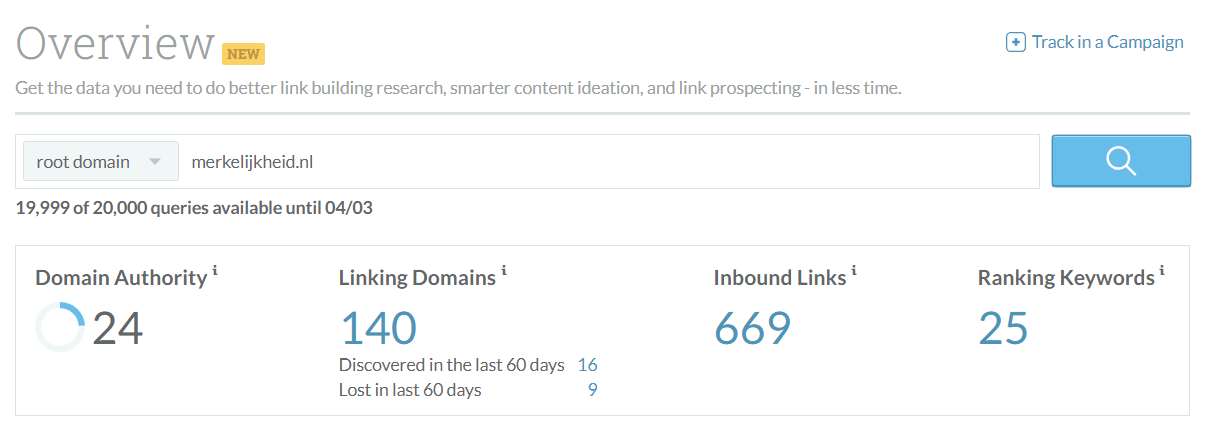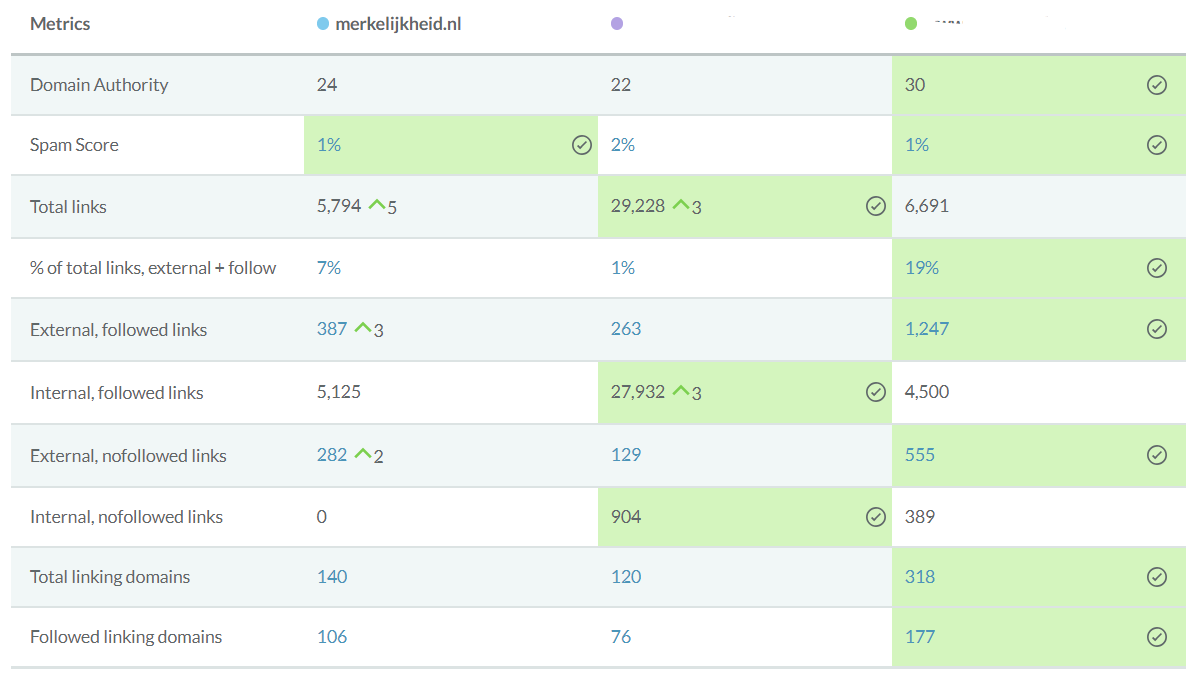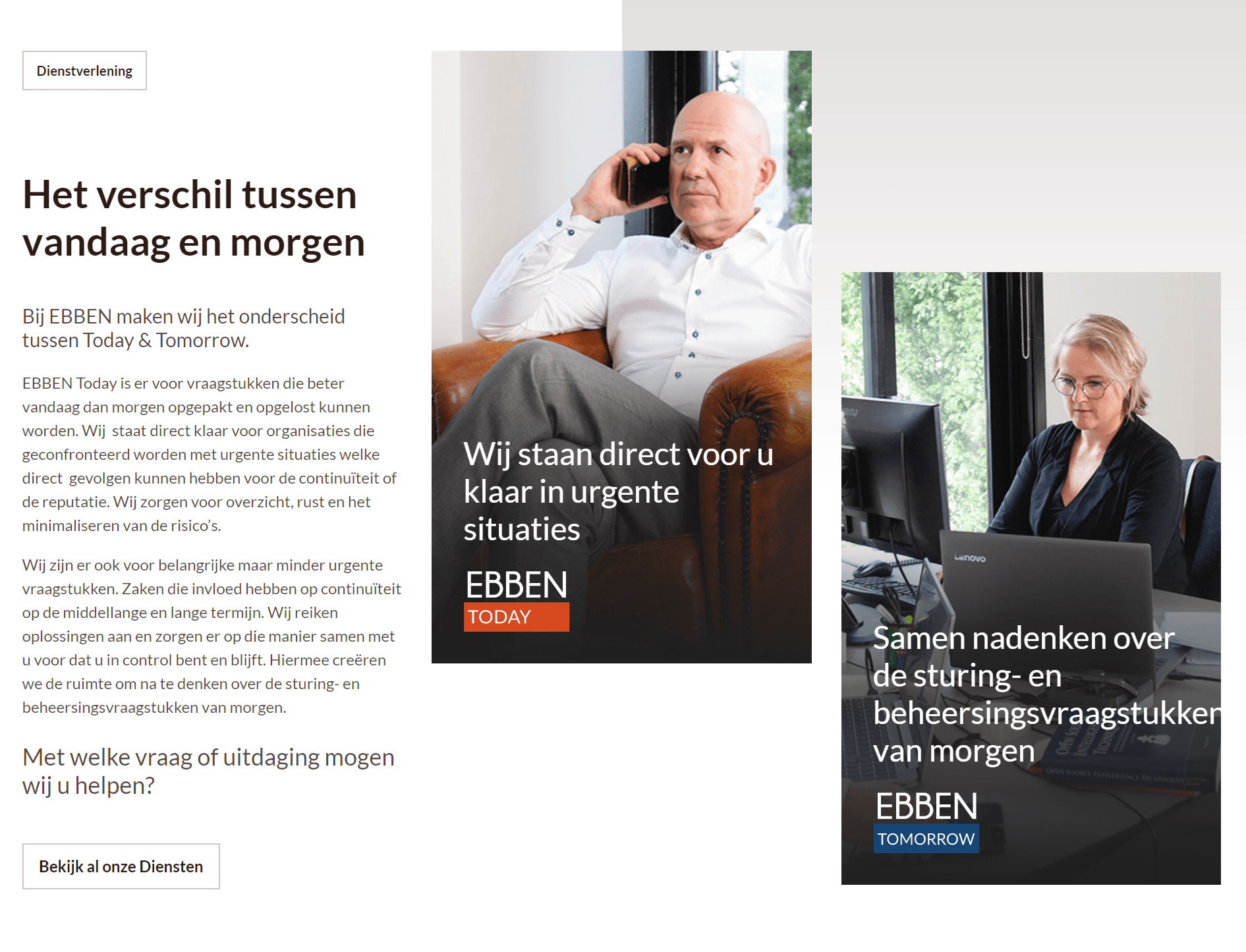*Ongecategoriseerd
Domain Authority: makes online marketing results measurable
How does your online marketing perform compared to the competition?Domain Authority is a single number that shows which site ranks highest in Google’s search results. If you score 25 and the main competitors no higher than 20, your new article will likely appear at the top. This is why many online marketing experts use Domain Authority as one of their key KPIs.
In this article, we explain what Domain Authority is, how to use it, and what you can do to improve your score.
What is Domain Authority?
Domain Authority is a number from 0 to 100 that predicts how high your site will rank in Google (or Bing). The higher your score compared to competitors, the greater the chance your site will appear at the top when someone enters a search term.

A quick scan of Merkelijkheid’s Domain Authority
But on its own, Domain Authority says little. It only makes sense to use Domain Authority in comparison with the main competitors. A Domain Authority of 30 is nothing to be ashamed of, but if the competition averages 40, you face a big challenge.
And that is the main challenge for a new brand: Domain Authority is a logarithmic scale (think decibels). This means that growing from 30 to 40 is much harder than growing from 20 to 30.
What is your Domain Authority?
Check your Domain Authority by entering your site’s URL in the Link Explorer. Also, first take a look at the main competitors before making a judgment.
Not from Google
Although almost every SEO expert uses Domain Authority, it is not a number published by Google. Google keeps the actual factors that determine a site’s position in the search engine strictly secret.
SEO specialist MOZ developed Domain Authority to approximate this as best as possible and it has since become the industry standard.
How is Domain Authority determined?
MOZ, like Google, keeps the exact algorithm for Domain Authority secret. But it clearly indicates how it can be improved: Search Engine Optimization (SEO) and good content! That probably comes as no surprise.
But what are the main factors? Experts agree on the following;
- Number of links,
- From different domains,
- With a high Domain Authority themselves,
- Number of links from domains with a higher SpamScore (negative),
- Internal link network on the site itself,
- Technical optimization
MOZ crawls the web like Google and maintains a database of websites and content. Their algorithm determines your Domain Authority based on this database. Behind the scenes, the company continuously works on improving this calculation model and regularly releases updates.

The main Domain Authority variables for merkelijkheid.nl
Major changes are often announced separately. For example, in March 2019, a major Domain Authority update was released that, according to MOZ, further improved the algorithm’s precision.
How do you use Domain Authority?
Domain Authority is used in practice as the KPI for the success of the online marketing strategy.
Firstly, because one easy-to-explain number works well with management or the board. You can compare apples to apples without having to explain for an hour how it all works.
Secondly;
- Long-term perspective instead of short-term actions
- Every future expression benefits from a higher Domain Authority
- Makes the value of a website tangible
- No seasonal influences (fewer visitors during summer holidays)
In short, focusing on Domain Authority is in the interest of both the responsible party and the company. This is why Domain Authority is considered the industry standard.
Help with improving Domain Authority
For many companies, it is worthwhile to enlist the help of experts. Depending on where the opportunities lie (and determining that), the following expertise is important:
- Online marketing strategy
- Developer/programmer
- Front-end specialist
- SEO specialist
- Content Marketer
- Analytics and Tag Manager specialist

Merkelijkheid has all this expertise in-house and therefore works for various companies on increasing Domain Authority. As a fixed partner in online marketing and SEO, we help with setting up a strategy, determining actions, and ensuring their realization. One of our central tools is, of course, the professional package from the creator of Domain Authority, MOZ.
Increasing Domain Authority
How do I ensure my Domain Authority rises? In a nutshell: by getting more good links and removing bad links.
But you probably already figured that out.
The question is: How do I do that?
Increase Domain Authority by removing bad links
Removing bad links is the easiest step: analyze which links you do not want and ask if they can be removed. If there is no response, you can request ‘Disavow Links’ via Google Search Console, so Google no longer considers these links. https://www.google.com/webmasters/tools/disavow-links-main
Higher Domain Authority through technical optimization
Search engines (and the Domain Authority algorithm) use a so-called crawler. A robot that views web pages and stores them in a database. Therefore, it is crucial that your website is set up so the robot can quickly find what you consider important.
This is the basis of SEO and therefore the first step towards a higher Domain Authority. A complete list goes beyond the scope of this article, but important factors for a well-indexed website are:
- Structure (how pages and posts relate to each other)
- Good navigation (clear buttons with the right text, functioning menu)
- URL structure (no 3456-technical.htm or /435/986id-news.aspx but rather yoursite.nl/title-news-article/)
- Use of the correct H1 and H2 headings
- Number of words per page or article
- Choice of clear keywords
- Correct alt tags for images
- Meta descriptions and titles
Improve existing links or get mentions to link

Our own link profile based on Domain Authority
In almost all cases, links already point to a website. These are sometimes outdated or link to the wrong page, and there is much to gain here. Send an email to the site administrator and ensure they can fix it.
Also, sites that mention your company or product but have not placed a link are a possible quick win. Send the administrator an email indicating what a good target for their link could be.
Suppliers or other existing relationships are often relatively easy to persuade to place a link to your site.
Generate new links: unique content
In practice, you often only get new links if there is something (content) on your site worth linking to! It’s no coincidence they say: Content is King.
So regularly create articles, photos, videos, or whitepapers that stand head and shoulders above the competition and share them in the best way with your entire network. Motivate colleagues to forward it and submit the article to trade magazines. Especially in the beginning, one link can make all the difference and raise your Domain Authority by a few points.
Slow and steady wins the race
The most important factor for a higher Domain Authority remains patience. It takes time before Google and MOZ count new links and even more time before they fully impact search results. A too large jump will always be curbed because the algorithm thinks cheating is involved.
So make sure you regularly;
- Produce new, quality content,
- Keep your site technically in order,
- Remove bad links,
- Keep sharing your content through various channels.
Then I can promise you one thing: your Domain Authority will rise. Want to know more about Domain Authority or online marketing? Read more on our online marketing page.